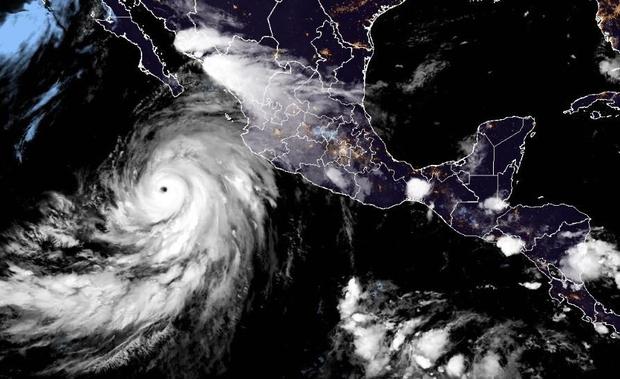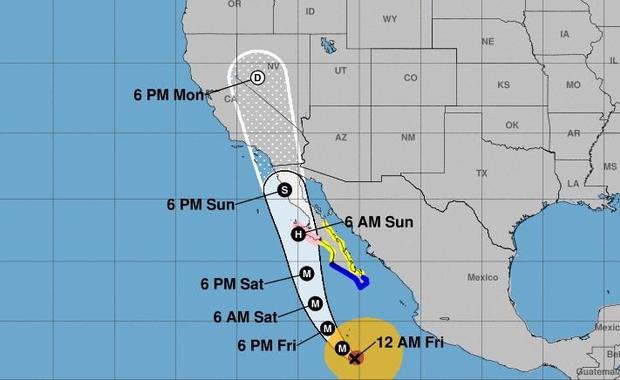Hurricane Hilary path and timeline: Here's when and where the storm is projected to hit California
Hurricane Hilary is expected to hit Southern California as a tropical storm, bringing heavy rainfall as early as this weekend after it makes its way up Mexico's Baja California Peninsula.
Forecasters said the storm is expected to produce 3 to 6 inches of rainfall, with maximum amounts of 10 inches, across portions of Baja California through Sunday night, with the possibility of flash flooding. The same rain totals are forecast for parts of Southern California and southern Nevada, according to the National Hurricane Center.
There will likely be "damaging wind gusts," especially at higher elevations, in the area, and swells along the coast, Greg Postel, a hurricane and storm specialist at the Weather Channel, told CBS News.
Tropical storm watches and warnings were in effect for parts of the Baja California Peninsula and mainland Mexico. A Tropical storm was in effect Friday for the area stretching from the California-Mexico border to the Orange/Los Angeles County Line, and for Catalina Island.

Where is Hurricane Hilary's projected path?
As of Friday morning, Hurricane Hilary was located about 360 miles southwest of Cabo San Lucas, Mexico, with maximum sustained winds of 145 mph, making it a "major" Category 4, the NHC said, adding that it is "large and powerful."
The storm was moving northwest at 10 mph, with a turn toward the northwest expected Friday, according to the center.

When will Hurricane Hilary hit the coast of California?
The center of the storm will approach Mexico's Baja California Peninsula over the weekend, NHC said, and weaken to a tropical storm before hitting California. It is set to impact the southwestern U.S. with heavy rainfall, possibly bringing "rare and dangerous flooding," according to the National Hurricane Center.
"It is rare — indeed nearly unprecedented in the modern record — to have a tropical system like this move through Southern California," Postel told CBS News.
The last time Southern California was hit by a tropical storm was in 1939, before storms were given names, CBS News senior weather and climate producer David Parkinson said. Several storms that had been hurricanes or tropical storms have impacted the state since then, but they had weakened to sub-tropical systems by that time, Parkinson noted.
The projected path of the storm showed it could make landfall anywhere from the Baja California Peninsula to as far north as Santa Barbara, California. One model showed the heaviest rain hitting the Palm Springs area after the storm makes landfall.
"But if this storm track moves just 40 miles to the west ... now you take all of this heavy rain ... and you shift it now into portions of Orange County. You shift it into portions of the [Inland Empire] that are very well populated," Parkinson said.
Either situation would be cause for concern, Parkinson noted. The desert terrain around Palm Springs would not be able to handle the amount of rain expected and, if the track shifts west, the areas scorched by recent wildfires would also be inundated.
Hilary is likely to produce landslides and mudslides in certain areas recently burned by wildfires and storm surges along parts of the southern Baja Peninsula and the Gulf of California coast, the Weather Channel reports.
"You're looking at a winter-like storm now in the summer in places that are not used to this amount of rain," Parkinson said.
- In:
- Hurricane
Disclaimer: The copyright of this article belongs to the original author. Reposting this article is solely for the purpose of information dissemination and does not constitute any investment advice. If there is any infringement, please contact us immediately. We will make corrections or deletions as necessary. Thank you.





